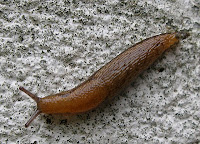 |
| stick insect on end of a tree trunk |
I enjoy watching shows such as PBS's Nature, whose cameras give me a peak into the world of such animals. On TV nature documentaries, however, the narrator usually talks about the evolution of the features of the stick insect, chameleon, or other camouflaged creature. Andrew Parker points to the other side of the coin, which is equally important. Namely, the evolution of vision in the predator who sees (or does not see) that camouflaged prey.
Those two sides of one coin thus demonstrate one type of what evolutionary biologists call co-evolution, which means that features of two species evolve in conjunction with each other. The two sides, camouflaged prey and seeing predator, evolved together -- each driving the evolution of the other. Camouflage is an example of one of the paradoxical forms of co-evolution. Part of the paradox is that predators have improved the evolution of their camouflaged prey, making what they want to catch harder to catch. The paradox also extends to the other side of the coin: The increased camouflage of the prey improves the evolution of the predator species' eyes, making the prey easier to catch. A sneeky, unconscious cooperation between what seem to be enemies.
This also means that as we look at Nature, a great deal of the diversity of appearances we see has resulted from the evolution of the eyes and power of vision in animals. We see a world shaped by sight. It also means that as I delight in looking at the almost amusing stick insect, I am also getting a glimpse into the vision and mind of whatever preys upon that insect. Thus, in a way, I see some of what animals see... but only up to a point. Through contemporary scientific research, we also know that some animals eyes can see things our human eyes cannot, such as the ultraviolet end of the spectrum. To some degree, the worlds of other animals must remain their own, not meant for our eyes.
~~~
Do you remember every seeing an insect, lizard, or other animal whose color especially interested you? Do you know why that species had evolved that way?
(The quotation by Parker is from Seven Deadly Colours, by Andrew Parker, © 2005. p.265.)
(The photo of the stick insect is used under a under a
Creative Commons Attribution-Share Alike 3.0 Unported license [no name given].)
(The photo of the stick insect is used under a under a
Creative Commons Attribution-Share Alike 3.0 Unported license [no name given].)


.jpg)


